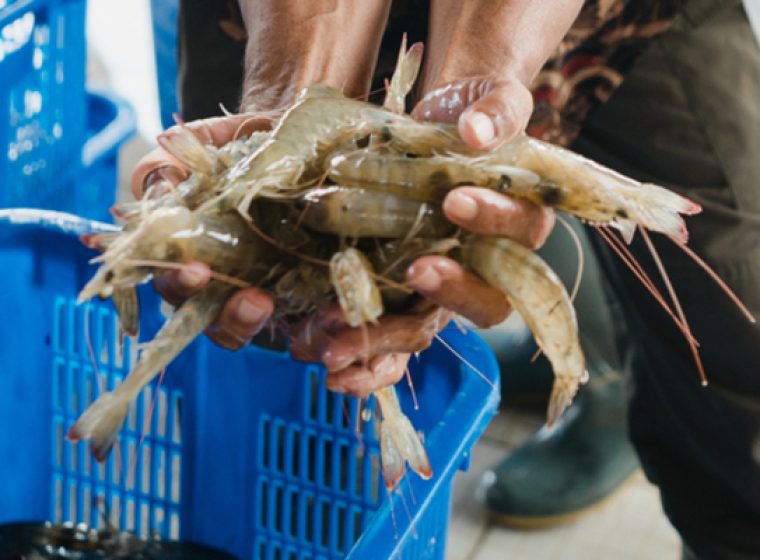The export of vannamei shrimp has been carried out by various parties for years. This is because vannamei shrimp is highly sought after in the global market. However, to engage in export activities, you need to be familiar with the procedures beforehand.
Exporting vannamei shrimp is neither difficult nor easy. You need to fully understand the procedures set by the Indonesian government and the procedures of the destination country for your exports.
Well, to learn more, let’s read the article about how to export vannamei shrimp below!
Also Read: Promising Vannamei Shrimp Cultivation Prospect and Export Opportunities
What are the Prospects for Vannamei Shrimp Export in the Global Market?
Vannamei shrimp is known for its delicious meat, good texture, versatility in creating various tasty dishes, and its affordable price. It’s no wonder that the demand for this shrimp continues to rise year after year.
In Indonesia, vannamei shrimp is one of the highest exported commodities with profits reaching millions of US dollars. Vannamei shrimp has contributed up to 36% of Indonesia’s total fishery export commodities, indicating its high demand in the global market.
According to data from the Ministry of Marine Affairs and Fisheries (MMAF), Indonesia’s shrimp production has consistently increased over the years. In 2022, Indonesia produced 1,099,976 tons of shrimp. This value is expected to rise in 2023, targeting 1,829,000 tons, and 2 million tons in 2024.
These targets are considered quite realistic given Indonesia’s high potential for cultivation, including a land area of at least 2.9 million hectares, favourable cultivation climate year-round, and adequate water resources.
Destination Countries for Indonesian Shrimp Exports
Indonesia ranks as the fourth-largest shrimp-exporting country in the world. This figure is expected to increase in the coming years, potentially making Indonesia the largest shrimp exporter globally. Some of the destination countries for Indonesian shrimp exports include:
1. Singapore
Singapore ranks first as the largest destination for Indonesian cultivated shrimp exports, reaching 1.89 million kg or about 8.2 million US dollars in 2021.
2. Malaysia
Besides Singapore, Indonesia’s neighbouring country, Malaysia, ranks second as a destination for Indonesian shrimp exports.
In 2021, Indonesia exported a total of 2.07 million kilograms of shrimp, equivalent to 3.38 million US dollars, to Malaysia.
3. China
China ranks third as a destination for Indonesian shrimp exports. In 2021, Indonesia exported 733.3 thousand kilograms of shrimp, valued at 13.8 million US dollars, to China.
4. South Korea
Another East Asian country that is a destination for Indonesian shrimp exports is South Korea. In 2021, Indonesia exported 69.19 thousand kilograms of shrimp to South Korea.
5. United States
The United States market is a major target for Indonesian vannamei shrimp exports. High seafood consumption in the US and the demand for quality vannamei shrimp make this market very promising.
However, Indonesia must compete with several Latin American countries like Ecuador to establish a presence in the US market.
6. European Union
Countries in the European Union are also significant markets for Indonesian vannamei shrimp exports. Stringent regulations regarding quality and food safety in the EU require Indonesian shrimp producers to meet strict standards to enter this market.
7. Japan
As the largest consumer of shrimp in the world, Japan is also a destination for Indonesian vannamei shrimp exports. This is because Japan does not have a production area for shrimp cultivation.
Some commonly consumed shrimp varieties in Japan are giant tiger shrimp (udang windu) and white leg shrimp (udang vaname).
Also Read: These are 7 Tips for Successful and Profitable Vannamei Shrimp Harvest
Export Criteria for Vannamei Shrimp
For a successful shrimp export process, it’s important to meet specific quality criteria. Some criteria that must be met include:
1. Size and Weight
Exported vannamei shrimp must meet the size and weight standards set by the destination country. Uniform size and weight help maintain consistency in the shipped products.
2. Quality and Appearance
Shrimp must be in the best condition and appearance for export. Avoid physical damages like wounds, defects, or detached body parts. Additionally, ensure that the color and skin texture are normal.
3. Cleanliness and Safety
Shrimp must be clean and free from contaminants that could pose a health risk to consumers. Both shrimp cultivation and processing, up to packaging, should prioritize cleanliness and hygieness.
4. Processing and Packaging
Shrimp must be processed and packaged correctly according to international standards. This involves cleaning, peeling, freezing, and appropriate packaging without damaging the shrimp’s body parts.
Guidelines for Vannamei Shrimp Export
To ensure a successful export process for vannamei shrimp, follow the guidelines below:
1. Selection and Preparation of Shrimp
Choose shrimp that meet the export criteria in terms of size, weight, and quality. Ensure that the shrimp have undergone health and safety inspections for consumption.
2. Proper and Standardized Packaging
Ensure that you have packaged the shrimp according to standards, whether it’s frozen or fresh shrimp.
Good export packaging for shrimp involves using materials that can withstand temperature and humidity changes.
3. Set the Right Price
Before exporting, establish an appropriate price for the shrimp you intend to export. The right price is competitive in the market without being too low or too high.
An appropriate price will enhance the attractiveness of your shrimp in the export market, especially if supported by high-quality products that have a demand increase.
4. Prepare Official Documents
For a smooth vannamei shrimp export process, you need to prepare various required official documents. These documents include those needed in both Indonesia and the export destination country.
Some of the required documents include:
- Invoice
- Hazard Analysis Critical Control Point (HACCP) Certificate with at least grade B
- Business Identification Number (NIB)
- Trading Business License (SIUP)
- Tax Statement (SKP)
- Internal Audit Records
- Application Letter for Registration Number
- Statement of Registration Number Utilization
5. Create Export-Import Contracts
Creating an official contract between the exporter and importer is important. Contracts typically include information about the type, quantity, price, delivery schedule, and description of the shrimp to be exported.
Both parties should agree on the terms outlined in the contract.
6. Choose the Best Distribution Route
Export commodities can be distributed through two routes: sea and air. Generally, the sea route is more affordable compared to air freight. However, it does have a longer travel time.
Also Read: Aquatech Startup Delos Believes That Indonesia Will Become The Largest Shrimp Exporter
Start Exporting Vannamei Shrimp with AquaLink!
After reading the prospects and guidelines for exporting vannamei shrimp above, are you becoming interested in entering this business? If so, it’s crucial to find the right partner to embark on this journey.
For this purpose, you can choose AquaLink as your shrimp export partner! With AquaLink, you can engage in shrimp exports at the best prices.
Contact the DELOS AquaLink team at contact@delosaqua.com or submit your inquiries through the contact form on our website www.delosaqua.com. Start exporting vannamei shrimp with AquaLink!




